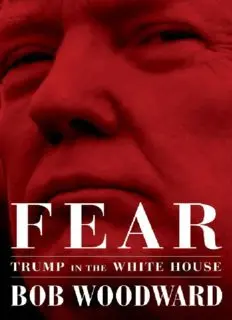
Fear: Trump in the White House PDF
Preview Fear: Trump in the White House
Thank you for downloading this Simon & Schuster ebook. Get a FREE ebook when you join our mailing list. Plus, get updates on new releases, deals, recommended reads, and more from Simon & Schuster. Click below to sign up and see terms and conditions. CLICK HERE TO SIGN UP Already a subscriber? Provide your email again so we can register this ebook and send you more of what you like to read. You will continue to receive exclusive offers in your inbox. Contents EPIGRAPH AUTHOR’S PERSONAL NOTE NOTE TO READERS Prologue Chapters 1–42 PHOTOGRAPHS ACKNOWLEDGMENTS ABOUT THE AUTHOR SOURCE NOTES INDEX PHOTOGRAPHY CREDITS To Elsa “Real power is—I don’t even want to use the word—fear.” Presidential candidate Donald J. Trump in an interview with Bob Woodward and Robert Costa on March 31, 2016, at the Old Post Office Pavilion, Trump International Hotel, Washington, D.C. Author’s Personal Note A heartfelt thanks to Evelyn M. Duffy, my assistant on five books that have covered four presidents. President Trump presents a particular hurdle because of the deep emotions and passions he brings out in supporters and critics. Evelyn immediately grasped that the challenge was to get new information, authenticate it and put it in context while reporting as deeply as possible inside the White House. Evelyn knew this was history and we had to get as much as possible quickly while memories were fresh and documentation and notes still available. At times we researched, interviewed, transcribed and rewrote sections of the book in a day or two covering foreign policy from North Korea to Afghanistan and the Middle East; and on the full range of domestic issues from trade, immigration and taxes. She made sure we built the story around specific scenes with specific dates, named participants and accounts of what happened. Evelyn maintains a remarkable work ethic and the deepest sense of fairness, curiosity and honesty. She provided me with thick packets of research, background, chronologies, clips, her insights, a list of major unanswered questions and additional interviews to pursue. Evelyn brought her endless good sense and wisdom, serving as full collaborator and in the spirit—and with the level of effort—of a coauthor. Note to Readers Interviews for this book were conducted under the journalist ground rule of “deep background.” This means that all the information could be used but I would not say who provided it. The book is drawn from hundreds of hours of interviews with firsthand participants and witnesses to these events. Nearly all allowed me to tape- record our interviews so the story could be told with more precision. When I have attributed exact quotations, thoughts or conclusions to the participants, that information comes from the person, a colleague with direct knowledge, or from meeting notes, personal diaries, files and government or personal documents. President Trump declined to be interviewed for this book. PROLOGUE I n early September 2017, in the eighth month of the Trump presidency, Gary Cohn, the former president of Goldman Sachs and the president’s top economic adviser in the White House, moved cautiously toward the Resolute Desk in the Oval Office. In his 27 years at Goldman, Cohn—6-foot-3, bald, brash and full of self- confidence—had made billions for his clients and hundreds of millions for himself. He had granted himself walk-in privileges to Trump’s Oval Office, and the president had accepted that arrangement. On the desk was a one-page draft letter from the president addressed to the president of South Korea, terminating the United States–Korea Free Trade Agreement, known as KORUS. Cohn was appalled. For months Trump had threatened to withdraw from the agreement, one of the foundations of an economic relationship, a military alliance and, most important, top secret intelligence operations and capabilities. Under a treaty dating back to the 1950s, the United States stationed 28,500 U.S. troops in the South and operated the most highly classified and sensitive Special Access Programs (SAP), which provided sophisticated Top Secret, codeword intelligence and military capabilities. North Korean ICBM missiles now had the capability to carry a nuclear weapon, perhaps to the American homeland. A missile from North Korea would take 38 minutes to reach Los Angeles. These programs enabled the United States to detect an ICBM launch in North Korea within seven seconds. The equivalent capability in Alaska took 15 minutes— an astonishing time differential. The ability to detect a launch in seven seconds would give the United States military the time to shoot down a North Korean missile. It is perhaps the most
